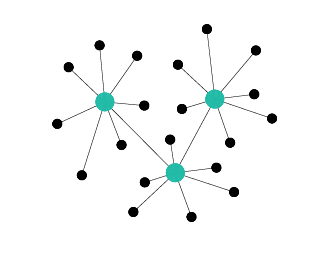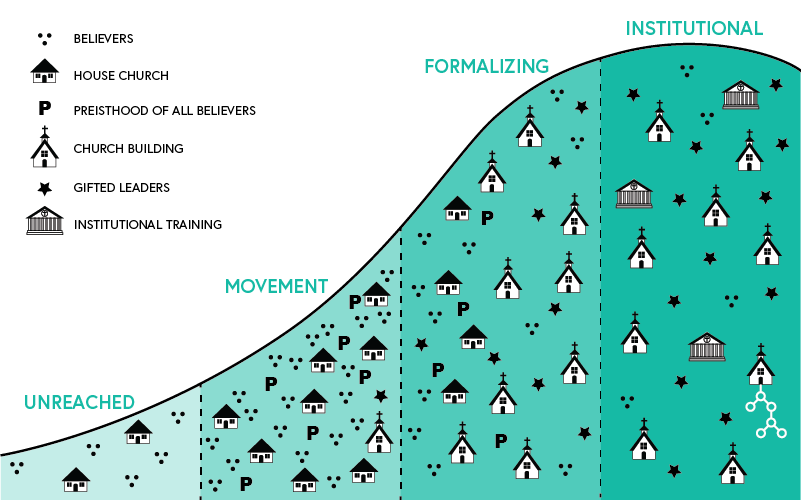Discipleship Tool
MODULE 2 — STEWARDING NETWORKS & RELATIONSHIPS | GET A COACH | MODULE 1 | SERIES LIBRARY
411
GOSPEL CONVERSATION TRAINING
WHY
Why should I share the gospel?
- God's Love:
— John 3:16-18
— Ephesians 2:4-7 - God's Glory:
— Habakkuk 2:14
— Ephesians 1:11-14
— 2 Thessalonians 2:13-14 - God's Command:
— Matthew 28:18-20 - Are you willing to give Jesus all authority in your life?
- Are you willing to go tell others about Jesus?
- Are you willing to make disciples?
- Are you willing to go to all nations?
- Are you willing to baptize others?
- Are you willing to teach others to obey the commands of Christ?
- Do you believe that Jesus is with you?
WHO
Who should I share the gospel with?
- List of 20:
Make a list of people in your relational network — friends, family, coworkers, classmates, and neighbors.
WHEN
When should I share with others?
- Pray:
Set a time to pray for the people on your list. - Train:
Set a time to train a fellow believer. - Share:
Set a time to share the gospel on your list.
411 GOSPEL CONVERSATION TRAINING (Four Questions on One Paper in One Hour) is a simple way to train others to share the gospel. This can be a training for existing believers or a training use to help start brand new disciples of Jesus to start sharing their faith right away.
But in your hearts revere Christ as Lord. Always be prepared to give an answer to everyone who asks you to give the reason for the hope that you have. But do this with gentleness and respect, keeping a clear conscience, so that those who speak maliciously against your good behavior in Christ may be ashamed of their slander.
— 1 Peter 3:15-16
Jesus said, "My prayer is not for them alone. I pray also for those who will believe in me through their message"
— John 17:20
IRON ON IRON — PEER MENTORING GROUP uses leader-to-leader mentoring with individual followers of Jesus, with simple churches, with ministry organizations or even with simple church networks.
As iron sharpens iron, so one person sharpens another.
— Proverbs 27:17
The purpose of a Peer Mentoring Group is to provide a simple format for helping followers of Jesus grow through prayer, obedience, application and accountability. In other words — "to love one another."
Jesus said, "A new command I give you: Love one another. As I have loved you, so you must love one another. By this everyone will know that you are my disciples, if you love one another."
— John 13:34-35
PURPOSE: Learning from other practitioners while addressing barriers and clarifying action steps that address barriers.
RULES: Be humble. Be patient. Be kind. Be serious. Attack the plan, not the person.
FOCUS: Do this with the lostness of your community in mind. Focus only on the barriers, not your opinions.
SCHEDULE: 60 minutes
ROLES: Respondent (one), Facilitator (one), Time Keeper (one), Participants (others)
1. REPORT (30 min):
- PRAY
- ABIDING (2 min):
- Are you personally abiding in Jesus regularly?
- CONFLICT (2 min):
- Is there any unforgiveness in your heart or unresolved conflict on your team?
- VISION (2 min):
- What is the local vision you are laboring towards?
- CONTEXT (2 min):
- Describe your context (city, people groups, etc).
- TOOLS (2 min):
- Briefly share what tools you are using in each field of 4 Fields.
- TIME (2 min):
- Briefly share your weekly ministry rhythm/schedule of how you’re investing your time to advance the Kingdom (pray, share, disciple, church, coach).
- TRAIN # (2 min):
- Estimated number trained by your team/network (if applicable).
- SHARE # (2 min):
- Estimated daily sustained gospel shares in your city.
- UPDATE # (4 min):
- Share the update/story of what God is doing using generational map focusing on your most fruitful streams.
- BARRIERS (10 min):
- Share the barriers/obstacles you are facing on the path to multiplication of healthy, sustained disciples and churches (focus on your most fruitful streams or use Four Fields diagram to diagnose).
2. REVIEW (30 min):
[Facilitator reviews the barriers to focus solutions on. Other Participants give encouragement and suggestions.]
- ENCOURAGEMENT (5 min):
- Give encouragement to the person who is sharing.
- QUESTIONS (5 min):
- Ask clarifying questions about what has been shared.
- SOLUTIONS (10 min):
- Discuss solutions that address barriers (scripture, stories, suggestions).
- TAKEAWAYS (5 min):
- Share 1-2 key takeaways/things that you think will help you moving forward.
- ACTIONS (5 min):
- Share your action items for the next 30 days and your accountability plan.
- PRAY:
- Pray over the actions.
1. REPORT (30 min):
- PRAY
- RELATIONSHIPS (10 min):
- How is your time reading and praying?
- Is there any conflict with a believer that you need to resolve?
- STATUS (10 min):
- What is happening in your work that is exciting to you?
- What successes do you feel like you are seeing?
- BARRIERS (10 min):
- What barriers are you facing in your field?
- What barriers are preventing further multiplication of disciples and churches?
2. REVIEW (30 min):
[Facilitator reviews the barriers to focus solutions on. Other Participants give encouragement and suggestions.]
- ENCOURAGEMENT (5 min):
- Give encouragement to the person who is sharing.
- QUESTIONS (5 min):
- Ask clarifying questions about what has been shared.
- SOLUTIONS (10 min):
- Discuss solutions that address barriers (scripture, stories, suggestions).
- TAKEAWAYS (5 min):
- Share 1-2 key takeaways/things that you think will help you moving forward.
- ACTIONS (5 min):
- Share your action items for the next 30 days and your accountability plan.
- PRAY:
- Pray over the actions.
THE VOICE OF FLESH

The voice of flesh is a voice that is expressed in the deep down desires of the heart. With maturity comes an ordered awareness of these desires and the ability to fulfill them. You are designed by God to desire to be fruitful, to change the world for the better, and to love and serve the Lord Jesus with all that you are by loving and serving His creation. Be assured that because it was He who put those desires in your heart, it is He who will allow you to fulfill them. Sometimes, however, our deepest desires are in conflict. The sinfulness of our fallen nature can clamor loudly. Sometimes our voice is in conflict with the voice of God. We are always in need of deeper conversion.
THE VOICE OF WORLD

The voice of world is a voice that is under the dominion of the devil, and thus could be considered an extension of his voice. It calls us to put our trust in the things of this world: prestige, money, fame, relationships, importance. It is the voice we hear in advertising, on TV shows, and in much of the music on the radio. The "noise" mentioned before is part of the voice of world. This voice tempts us to forget about our salvation and God’s call in our life. The alluring things that appeal to the flesh often drown out the voice of God and His love.
THE VOICE OF DEVIL

The voice of devil is a voice that is always trying to lead us away from Jesus and to keep us enslaved to him. His voice always tells us to doubt God’s goodness and not to trust in Him. It is the voice that says, "I know more than He does." It is the voice that tells us to say "no" to Jesus. The most obvious example of the voice of devil is the temptation to sin. If the devil cannot get us to fall into sin, he then will try to get us to choose something that, while good in itself, is not the good that Jesus wants for us. In other words, the voice of devil can try to make us choose a less perfect life than that which God has prepared for us.
THE VOICE OF GOD

The voice of God is a voice that is communicating His constant and unfailing love to us. We hear His voice through the scripture and Holy Spirit urging us to do that which is good, to trust in Him and to sacrifice out of love. Discouragement and confusion are never the voice of Jesus, which expresses courage and truth as he calls us to a deeper conversion in the face of sin. His voice is never deceptive and He will give you the graces to accomplish whatever He calls you to do. When we are tempted to think that Jesus is calling us to a life that we do not want or cannot accomplish, it is not His voice that we are hearing, but that of another.
In the process of discernment we should become aware of four voices and need to learn to distinguish them from one another. Being attuned to the voice of God will make the other voices easier to separate. It is not always easy to tell these voices apart from one another, therefore discernment requires time, patience and perseverance in the face of struggle.
REFERENCE SCRIPTURES:
"Whoever belongs to God hears what God says. The reason you do not hear is that you do not belong to God."
— John 8:47
Listen and hear my voice; pay attention and hear what I say.
— Isaiah 28:23
Whether you turn to the right or to the left, your ears will hear a voice behind you, saying, "This is the way; walk in it."
— Isaiah 30:21
But solid food is for the mature, who by constant use have trained themselves to distinguish good from evil.
— Hebrews 5:14

VISION: every PERSON, PEOPLE, and PLACE
"This, then, is how you should pray: 'Our Father in heaven, hallowed be your name, your kingdom come,
your will be done, on earth as it is in heaven.'"
— Matthew 6:9-10
For the earth will be filled with the knowledge of the glory of the Lord as the waters cover the sea.
— Habakkuk 2:14
Then Jesus came to them and said, "All authority in heaven and on earth has been given to me. Therefore go and make disciples of all nations, baptizing them in the name of the Father and of the Son and of the Holy Spirit, and teaching them to obey everything I have commanded you. And surely I am with you always, to the very end of the age."
— Matthew 28:18-20
"But you will receive power when the Holy Spirit comes on you; and you will be my witnesses in Jerusalem, and in all Judea and Samaria, and to the ends of the earth."
— Acts 1:8
After this I looked, and there before me was a great multitude that no one could count, from every nation, tribe, people and language, standing before the throne and before the Lamb. They were wearing white robes and were holding palm branches in their hands. And they cried out in a loud voice: "Salvation belongs to our God, who sits on the throne, and to the Lamb."
— Revelation 7:9-10
PEOPLE | PLACES: THE LAST, THE LEAST, and THE LOST — List the people or places you want to reach.
Jesus told them another parable: "The kingdom of heaven is like a mustard seed, which a man took and planted in his field. Though it is the smallest of all seeds, yet when it grows, it is the largest of garden plants and becomes a tree, so that the birds come and perch in its branches."
— Matthew 13:31-32
By the power of signs and wonders, through the power of the Spirit of God. So from Jerusalem all the way around to Illyricum, I have fully proclaimed the gospel of Christ.
— Romans 15:19
MISSION: DISCIPLE-MAKING — Are we getting to 4th generation believers and groups? Use Generation Map to record.
And the things you have heard me say in the presence of many witnesses entrust to reliable people who will also be qualified to teach others.
— 2 Timothy 2:2
KINGDOM OF GOD (KINGDOM OF HEAVEN) or βασιλεία τοῦ θεοῦ (Basileia tou Theou) in the original Greek language — means REIGN OF GOD or KINGSHIP OF GOD — the Kingdom is GOD'S REIGN THROUGH GOD'S PEOPLE OVER GOD'S PLACE.
In a broader sense, the kingdom of God is the rule of an eternal sovereign God over all the universe. It represents the reign and the sovereignty of God.
In a narrower sense, the kingdom of God is a spiritual rule over the hearts and lives of those who willingly submit to God’s authority. It represents the heart of man.
The kingdom of God is already here now (in part) in the lives and hearts of the redeemed, as well as in perfection and fullness in the future.
GOD'S REIGN:
The Lord has established his throne in heaven, and his kingdom rules over all.
— Psalms 103:19
The Lord will be king over the whole earth. On that day there will be one Lord, and his name the only name.
— Zechariah 14:9
In the time of those kings, the God of heaven will set up a kingdom that will never be destroyed, nor will it be left to another people. It will crush all those kingdoms and bring them to an end, but it will itself endure forever.
— Daniel 2:44
How great are his signs, how mighty his wonders! His kingdom is an eternal kingdom; his dominion endures from generation to generation.
— Daniel 4:3
He was given authority, glory and sovereign power; all nations and peoples of every language worshiped him. His dominion is an everlasting dominion that will not pass away, and his kingdom is one that will never be destroyed.
— Daniel 7:14
The seventh angel sounded his trumpet, and there were loud voices in heaven, which said: "The kingdom of the world has become the kingdom of our Lord and of his Messiah, and he will reign for ever and ever."
— Revelation 11:15
GOD'S PEOPLE:
Jesus said, "The time has come," he said. "The kingdom of God has come near. Repent and believe the good news!"
— Mark 1:15
Jesus said, "Very truly I tell you, no one can see the kingdom of God unless they are born again. ... Very truly I tell you, no one can enter the kingdom of God unless they are born of water and the Spirit."
— John 3:3,5
Jesus said, "The one who sowed the good seed is the Son of Man. The field is the world, and the good seed stands for the people of the kingdom. The weeds are the people of the evil one."
— Matthew 13:37-38
Jesus said, "Therefore I tell you that the kingdom of God will be taken away from you and given to a people who will produce its fruit."
— Matthew 21:43
GOD'S PLACE:
Jesus said, "My kingdom is not of this world. If it were, my servants would fight to prevent my arrest by the Jewish leaders. But now my kingdom is from another place."
— John 18:36
Once, on being asked by the Pharisees when the kingdom of God would come, Jesus replied, "The coming of the kingdom of God is not something that can be observed."
— Luke 17:20
For the kingdom of God is not a matter of eating and drinking, but (a matter) of righteousness, peace and joy in the Holy Spirit.
— Romans 14:17
ALREADY BUT NOT-YET:
From that time on Jesus began to preach, "Repent, for the kingdom of heaven has come near."
— Matthew 4:17
Jesus said, "But if I drive out demons by the finger of God, then the kingdom of God has come upon you."
— Luke 11:20
Jesus said, "Nor will people say, ‘Here it is,’ or ‘There it is,’ because the kingdom of God is in your midst."
— Luke 17:21
For he has rescued us from the dominion of darkness and brought us into the kingdom of the Son he loves, in whom we have redemption, the forgiveness of sins.
— Colossians 1:13-14
Jesus said, "Then the King will say to those on his right, 'Come, you who are blessed by my Father; take your inheritance, the kingdom prepared for you since the creation of the world.'"
— Matthew 25:34
Jesus said, "For I tell you, I will not eat it again until it finds fulfillment in the kingdom of God. ... For I tell you I will not drink again from the fruit of the vine until the kingdom of God comes."
— Luke 22:16,18
ETERNAL LIFE is TO KNOW GOD THROUGH JESUS CHRIST — means being in the presence of the eternal God. It begins the moment a person exercises his faith in Christ during his life time and it extends into eternity.
Jesus said, "Now this is eternal life: that they know you, the only true God, and Jesus Christ, whom you have sent."
— John 17:3
Jesus said, "For God so loved the world that he gave his one and only Son, that whoever believes in him shall not perish but have eternal life."
— John 3:16
Jesus said, "Whoever believes in the Son has eternal life, but whoever rejects the Son will not see life, for God’s wrath remains on them."
— John 3:36
And this is the testimony: God has given us eternal life, and this life is in his Son. Whoever has the Son has life; whoever does not have the Son of God does not have life.
— 1 John 5:11–12

The FOUR FIELDS diagnostic chart is a simple tool to be used by a leadership cell to reflect on the status of current efforts and the Kingdom activity around them.
Jesus said, "This is what the kingdom of God is like. A man scatters seed on the ground. Night and day, whether he sleeps or gets up, the seed sprouts and grows, though he does not know how. All by itself the soil produces grain—first the stalk, then the head, then the full kernel in the head. As soon as the grain is ripe, he puts the sickle to it, because the harvest has come."
— Mark 4:26-29
Jesus often pulled the disciples back, away from ministry to quieter places to review how the work was going. This simple tool is to help you and the co-leaders with you to follow this pattern of Jesus and to address all parts of your stewardship.
Use the tool in peer mentoring to review activity, people, and groups by categorizing them into the different fields, and asking each other core questions to surface points of action and next steps.
FOUR FIELDS DIAGNOSTIC DIAGRAM:
- EMPTY FIELD — GO
- New Areas or People Groups
- Ask the question: Where or with whom (what people groups) are you planning to extend the Kingdom?
- Eyes to See
- Find the Lost: List of 100 • Person of Peace
- Train the Saved: Greatest Blessing • 411
- SEEDING FIELD — GOSPEL
- Gospel Shared and New Baptisms
- Ask the question: Where or with whom are you sharing the good news of the Kingdom? How are you doing that?
- My Story • God's Story • Prayer Walk • Stoplight
- GROWING FIELD — GROW
- New Groups Formed or People Trained
- Ask the question: How are you equipping people and growing them spiritually, individually and in their natural networks?
- S.O.A.P.S. • Prayer Wheel • Accountability Group • 3/3 Group
- HARVESTING FIELD — GATHER
- New Churches Formed
- Ask the question: How are new spiritual families (simple churches) being formed?
- M.A.W.L. • Healthy Church
- MULTIPLYING — GENERATIONS
- Leaders Training and Generations Added
- Ask the question: With whom, how and when are you filtering for faithful people, equipping and holding them accountable for reproduction?
- M.A.W.L. • Two Churches • Four Fields • Generation Map • Coaching Checklist • Iron on Iron • Fivefold Ministry
A
APOSTLE
P
PROPHET
E
EVANGELIST
S
SHEPHERD
T
TEACHER
So Christ himself gave the apostles, the prophets, the evangelists, the pastors and teachers, to equip his people for works of service, so that the body of Christ may be built up until we all reach unity in the faith and in the knowledge of the Son of God and become mature, attaining to the whole measure of the fullness of Christ.
— Ephesians 4:11-13
- APOSTLE: People who score highest with an Apostolic position are Dream Awakeners* in the Kingdom of God. They awaken people to their God designed potential. They are instrumental in people discovering who they really are, and walking alongside them to get there. They forge new paths in the Kingdom and are a catalyst for change wherever they go.
- PROPHET: People who score highest with a Prophetic position are Heart Revealers* in the Kingdom of God. They are effective in revealing God’s heart for His people where ever they go. They can accurately discern God’s heart for a situation. They help people experience God’s voice for the very first time and help them develop hearing the voice of God in their own life.
- EVANGELIST: People who score highest with an Evangelist position are Story Tellers* in the Kingdom of God. They make the stories of Jesus’s remarkable goodness and love famous. They are the carrier of good news and partner with Jesus in celebrating people’s transformation. They stir curiosity and desire to know Jesus. Their life is a living invitation to all to join the Family of God.
- SHEPHERD: People who score highest with a Shepherding position are Soul Healers* in the Kingdom of God. They are instrumental in guiding people through brokenness back to wholeness and healing their soul from wounds that keep them where they are. They create a safe atmosphere of family and belonging. They bring fun and enjoyment to God's ministry and allow people to feel like they are part of a greater family.
- TEACHER: People who score highest with a Teaching Position are Light Givers* in the Kingdom of God. They make the truth and knowledge about God accessible to all. They have an ability for breaking confusion and misinformation. They are strategic in helping people know the truth of God and also how it applies to their own life
FIVEFOLD MINISTRY TEST:
fivefoldministry.com designdiscovery.com
PERSONALITY TEST:
LEADERSHIP NETWORKS allows a growing group of simple churches to work together, grow new leaders and accomplish even more of the good things God has planned for His people.
So what happens to churches as they grow and start new churches that start new churches that start new churches? How do they stay connected? How do they live life together as an extended spiritual family?
When spiritual families (i.e. simple churches) reproduce, networks of related churches soon develop. These networks then function like a city or regional church.
It is at this city or regional level that we see elders and deacons functioning. It is also at this level the leadership gifts, such as apostle, prophet, evangelist, shepherd (pastor) and teacher come into play. These leadership gifts are primarily equipping gifts to prepare all disciples to be more effective in ministry. These leaders as well as the elders and deacons can serve a large number of spiritual families. We see this pattern in Scripture for example with the deacons in the Jerusalem church or the elders in the Ephesian church.
This sort of structure utilizes the same patterns at the macro level as are evident in the spiritual families at the micro level. The 3/3 pattern is evident in leadership training meetings and peer mentoring sessions. The Four Fields pattern is used for planning, evaluation and coaching at the higher levels. The main adjustment is that applications are in corporate terms rather than individual terms. The goals and activities are taken at the scale represented in the meeting.
Typically the area where the network starts becomes central in leadership terms. As the influence of that network expands, it essentially adds levels below the parent. For example, if a church network starts in Tampa, it will at first function as a city church in Tampa. As its influence spreads across the state of Florida, it may then function as a state church and have streams of daughter churches in various cities and counties. As it continues to grow it will begin to function at a national level and even an international level. There will be various streams of daughter churches in different states and countries around the world. These churches tend to remain connected because of their common DNA and parentage.
If some of the streams split off into their own networks due to convenience, language, or other factors, this is not a problem. If the DNA has been successfully passed on then everything needed to establish a new movement of multiplying disciples is present in every spiritual family or even every member of a spiritual family.
Typically, each church is small, having between 4 and 12 adults, along with their children. They are intergenerational, although teenagers can begin planting churches among their peers if they so desire. This small size makes it possible for the relationships to be more intimate, the accountability to be more effective, and the participation to be fuller.
The default pattern for people who come to Christ or who already follow Christ but are moving to a new area is not for them to join an existing church, but rather to be equipped to start a new spiritual family, which is then joined to the network. In this way, spiritual families can be kept small enough to be very fruitful and effective in disciple-making. Again, the small size makes it possible for the relationships to be more intimate, the accountability to be more effective, and the participation to be fuller.
The willingness of simple churches and individual followers to learn, obey and share God’s Word is the spiritual DNA of a movement. If it is passed on successfully from generation to generation, from church to church and from believer to believer then everything needed to begin a new movement of multiplying disciples is already present in every spiritual family and in every follower of Jesus.
When movements launch movements, that’s when we start to see the “leaven” working through the dough of a city or a state or even a nation. That is how the Kingdom of God comes in such a way that God’s will is being done on earth as it is in heaven.
That is how we can finish the Great Commission by making disciples of all nations.

FRACTAL is something where the pattern at the micro level is the same as the pattern at the macro level. We still have accountability expressed in three-third structure whenever we meet — looking back, looking up, looking forward, and so on, so that the patterns are familiar. As people move up in leadership, they’re not having to learn entire new patterns, everything is familiar and focused on the same principles. This is how the network’s function, and accountability takes place at each level in much the same fashion that it does in the local church, except that it’s corporate accountability.
CENTRALIZED

DECENTRALIZED

DISTRIBUTED

- CENTRALIZED NETWORK is a system in which one entity (a person or organization) holds the entire control. Resources are consolidated and shared within a single entity.
- DECENTRALIZED NETWORK is a system in which no single controlling entity. Instead, control is shared among several independent entities. Resources are shared within its own entity.
- DISTRIBUTED NETWORK is a system in which control is shared among interconnected entities. Resources are shared and distributed across its network.
OCTOPUS
[CELL CHURCH]

Multiple legs to reach out in different directions
Ability to regrow lost leg but old leg is lost
Complex and specialized
Central nervous system with brain
Delicate and very sensitive to its environment
STARFISH
[SIMPLE CHURCH]

Multiple legs to reach out in different directions
Ability to regrow lost leg and old leg will grow into a new body
Simple and non-specialized
Decentralized nervous system with no brain
Not picky to its environment
Simple church gatherings are very different from a regular small group or a cell group. Simple church is not just a Bible study—a supplement to a Sunday service—nor is it centered on a set teaching. Simple church is a real church that empowers all its members to take responsibility, support one another and share life together.
The primary difference between cell church and simple church network is in regard to structure. A cell church is hierarchical in structure, and teaching and authority flow from the top down. A simple church network is a network of autonomous simple churches which voluntarily cooperate together and submit to one another in mutual accountability. There are advantages and disadvantages to each form. The difference may perhaps best be illustrated by the difference between starfish and octopus.
Starfish represent simple churches. If you cut off the leg of a starfish, you get two starfish, and nothing is lost. With an octopus, if you cut off the leg, you get a new leg, and the old leg is lost. With a cell church the leadership level that develops in each cell is not nearly as mature as that which develops in an autonomous simple church because the cell group depend upon the hierarchy to provide regular teaching and structure and authority instead of learning to feed on scripture for themselves. So if, because of persecution or severed relationships or some other problem, the cell group breaks off from a cell church, it will typically die.
Similarly, with a starfish, if the head is destroyed, you get as many starfish as there are pieces of starfish. But, with an octopus, if the head is destroyed, the octopus is dead. In the cell church, if the senior leadership of this church is imprisoned or dies or falls into sin or some other problem, typically the church is seriously damaged or even killed. Whereas there is no problem like that with simple churches, because each unit is not reliant on the organization but is self-sufficient for feeding and growth.
Starfish are simple and non-specialized, whereas octopi are complex and specialized. This is true of cell churches and simple churches. A cell church that is complex and specialized can provide a myriad of services and opportunities which can never be offered by the simple churches because the simple churches are simple and non-specialized. They simply meet the simple, basic, straightforward needs, not the highly specialized needs. The authoritative structure in the cell church enables it to act with greater coordination than is possible with a simple church network.
One other advantage of starfish is that you can’t eliminate them even if you try. You can try chemicals or biological warfare against them, but they are very tough to eliminate. Whereas, octopi are an endangered species in areas where they come under environmental stress. This points out a fact that is true about cell churches. They are appropriate for only certain settings. They tend to be appropriate for urban settings but not rural settings and for authoritative societies but not consultative societies. Simple churches can thrive in both urban and rural settings in consultative and authoritative societies. They are much more versatile and adaptable than cell churches pattern.

Throughout history, most movements have gone through four phases or stages (and sometimes back again through grass-roots movements). Failure to understand these can create unreal expectations that are inappropriate for a given stage of a movement. This historical progression from the Unreached Phase to Institutional Phase can take years, decades or centuries. The goal is to understand the strengths and weaknesses of each stage and what we must navigate when we move from one to the other.
History is filled with this general story occurring over and over, nation by nation. It is also filled with stories of plateaued denominations in which fresh grass roots movements emerged by going back to principles of stage two. The challenge is to keep a movement at the movement stage as long as possible and to not let the formalizing impede the progress of the kingdom. But when it does begin to slow down, going back to simple biblical processes and methods of earlier stages can spark a new movement.
STAGE ONE – UNREACHED PHASE
In the beginning of a new mission work, the people group is unreached. Few believers or churches exist. Outsiders enter the context and lead people to faith. Persons of peace are discovered and networks of relationships are opened up through those who accept Christ. It is not uncommon to find some who may multiply gospel acceptance 30 times, 60 times and 100 times in their circle of influence.
In this early stage of what might become a movement of God, usually all forms and methods are rather simple. If they are not, then this mission work never becomes a movement.
- The number of Christians (represented by dots) is relatively small. The budding movement may be growing (represented by a line moving higher on the graph.) But most of the evangelism and church planting is being done by evangelists from outside the people group. Growth is still incremental.
- The few churches meet in informal places - homes, under trees or in other places already built (storefronts, offices, etc.). This is symbolized by a house. Again, most churches are being started by outsiders.
- An important step that must be taken is development of the concept of the priesthood of every believer (represented by "P"s). In this stage, though outsiders are initiating the evangelism and church planting, this budding work can become a movement if they instill in believers a strong concept of the priesthood of the believer. They must help believers not only to go directly to God but also to live out the priestly service of evangelizing and ministering to others. If they do not catch this concept, then the missionary work can remain in the unreached phase indefinitely – outside missionary experts doing all of the evangelism, discipleship, church planting and leading.
- Leadership development of local believers is very informal, usually happening in the churches or local context, just in time, mainly in the form of mentoring.
All of the forms are so simple at this stage, that with the right empowering and vision, the early stages may be fanned into a Church Planting Movement.
STAGE TWO – MOVEMENT PHASE
At this stage, multiplication of disciples and churches is occurring primarily because indigenous believers are captivated by the vision to reach their own people group and beyond. The number of believers begins to increase dramatically because the concept of the priesthood of every believer takes off (the line begins to rise more rapidly). As the Spirit empowers them through simple forms and methods, new communities are reached with the gospel.
Churches continue to meet in informal places such as homes and multiplication is the norm for most churches as they live with these simple forms. Leadership development usually occurs in the context of churches. Locally connected leadership networks develop where leaders with more responsibility gain additional training in context.
Indigenous believers do not wait for outsiders to initiate evangelism, baptism, discipleship, church planting or leadership of churches. The movement grows because of their confidence that they are commissioned and empowered to do the work of ministry. Most believers and leaders do not see a great "clergy/laity" divide.
A movement can remain in this stage for years or decades.
STAGE THREE – FORMALIZING PHASE
As the movement progresses, the number of believers continues to increase rapidly. A desire develops to standardize or formalize certain aspects of the movement (e.g. church formation, leadership development, etc.). Leadership development existed in the earlier phases but it was done intentionally in context – essentially theological education by extension.
As the movement formalizes, some churches begin to meet in purpose-built structures while some continue to meet in homes. Brick and mortar (or bamboo and tin) buildings emerge. (This is represented by a building with a cross on top.) Some of these brick and mortar churches become much larger than the average church meeting in a home.
Leadership development becomes more formalized as well. Dedicated institutions (represented by a colonnaded structure) begin to emerge to train more leaders and to do it in a more systematic manner. Certificates and credentials begin to emerge in the process. Some very gifted leaders begin to stand out amidst the leaders (represented by stars on the drawing). They are highly gifted evangelists, preachers, teachers and administrators. Lay pastoral leadership becomes less common and a professional leadership becomes more common.
The result is that normal disciples can be intimidated from doing the work of the ministry. They do not have the abilities or specialized training/credentials of the professional leaders. Therefore, the concept of the priesthood of the believer (in terms of "every member a minister") wanes. A smaller percentage of disciples continues in ministering to others. No one intends for this to occur, and many pastors will do their best in stages three and four to build up their church members as ministers and leaders, but the "clergy/laity" divide becomes more profound.
STAGE FOUR – INSTITUTIONAL PHASE
As the movement becomes more formalized, it inevitably moves to an institutional phase. Overall the movement may grow for a while due to the sheer number of churches and believers bearing witness. However, it is not uncommon for the movement to plateau, unable to keep pace with the birth rate.
At this stage, multitudes of believers exist. Churches are very common and accepted in society. The majority of churches meet in purpose-built structures and the requirements for what constitutes a church become more rigid. For a church to meet in a home is seen as odd and "not real church." Some churches become larger and some mega-churches emerge, though in many denominations, the vast majority of churches still average under a hundred in attendance.
Extremely gifted leaders emerge (represented by even larger stars on the diagram). Virtually all leadership development is now done in institutions – seminaries or Bible schools - and credentials are expected. A majority of leaders serve in full or part-time capacities. Lay leadership is less common, or at least less visible. The upshot is that the concept of priesthood of the believer wanes drastically. Believers bring their lost friends to church rather then lead them to faith themselves. Professional leaders do the work of ministry and find it difficult to motivate the average person in the pew to serve in lay ministry.
Institutions by the church become common (seminaries, publishing houses, hospitals, mission organizations, etc.) and often effect great impact through the manpower and budgets they wield.
STAGE FOUR WORKERS IN STAGE ONE
This whole process can take years, decades or centuries to develop. The early church does not appear to have entered this final stage until the Fourth Century A.D. Most movements progress through these stages. The difficulty comes when we lack this historical perspective and try to make sense of movements at earlier stages.
What happens when a missionary leaves a stage four church and tries to do evangelism and church planting in stage one? Inadvertently he tries to plant stage four disciples and churches because that is all he knows. One missionary in Sub-Saharan Africa expressed revelation upon seeing this diagram. He realized that when his organization pioneered work in his tribal people group, they attempted to start stage four churches from the beginning (complete with brick and mortar). He discovered that on average it took 22 years to plant a stage four church in stage one.
As Neill Mims was teaching a group of Korean missionaries, this question sparked an intense counseling session. Though a result of a mighty movement, Korean church culture is now extremely institutional. This chart gave these missionaries some understanding as to why their home churches and pastors expected them to start large churches or other institutions very quickly or be considered failures.
Leadership development also becomes a challenge. Local partners that I mobilized to reach an unreached people group in Asia needed one year of training-doing-retraining-doing-retraining before they understood basic reproducible patterns for evangelism, discipleship and church planting. After one year they finally were following a stage one and two pattern.
But when it came time to choose leaders, they naturally reverted to seeing through stage four eyes. They could not find any believers from the harvest to appoint as pastors. The reason was not the lack of biblical qualifications. The problem was that they were envisioning leaders from back home (stage four) – extremely gifted, exceptional teachers, highly mature spiritual life, administrative abilities, etc. It was not until they grasped the basics of Scripture and abandoned stage four expectations that they could develop local leaders appropriately at stage one. These indigenous leaders would continue to grow and mature as they were trained in the years to come.
STAGE TWO WORKERS IN STAGE FOUR
What happens with believers from stage one or two who visit leaders and churches in stage four? A not-uncommon consequence is death of the movement phase and immediately entering the formalizing and institutional phase.
Leaders from an emerging CPM left their mountain homes and descended into the plains where stage four churches and institution had existed for decades. When the leaders saw the marvelous buildings, institutions and gifted leaders, they longed to have the same thing. They returned to their mountain churches and immediately instituted stage four requirements for what constituted a church and who could lead. This effectively killed the progress of their movement.
STAGE FOUR LEADERS WATCHING A STAGE TWO MOVEMENT
When our whole frame of reference is stage four, it is easy to criticize what we see in stage two. We can easily label the house churches as "not real churches." Or, we can require that leaders meet certain credentialing requirements before they can perform the ordinances. Or, as we feel compassion for pastors that are bi-vocational, we may dedicate money to fund them full-time, thereby creating a benchmark that is no longer reproducible. In all, we can kill a movement when we implement extra-biblical requirements that are a yoke too heavy into these early stages.
It is easy to ridicule such movements because we have no frame of reference for them. Recently, as I spoke to 400 pastors, seminary professors and mission leaders about launching Church Planting Movements in the American context, I encountered many such questions. The idea of every believer being trained to make disciples and potentially start churches was a foreign concept.
LEADERSHIP CELLS equip individual believers in a short time to learn reproductive patterns that last a lifetime.
Nomads, students, military personnel, seasonal workers who already follow Jesus work great in a Leadership Cell. Because of their culture, their profession or their season of life — they may have a hard time establishing an ongoing group, but they can absolutely be trained how to start groups in each place they travel.
These special purpose groups help learners become leaders who will then start new groups, train new churches, and begin more leadership cells to grow God’s family.
Leadership Cells also work well when a group of people come to faith at the same time. A family, a network of friends, or even a small village can be trained in a short time to become producers for a lifetime — even without individual follow-ups or spiritual coaching.
Leadership Cells are 3/3 Groups that only meet for a limited and pre-determined length of time. The purpose is to equip a group of people to go out and establish their own groups or establish another leadership cell at the conclusion of the training period.
Rotate leadership in the group throughout every session so that everyone has a chance to lead, pray, or ask questions. Encourage and coach one another in what’s going right, what could be better with a little practice, and what a good next step would be for each member of the group to grow even more.
Cast all your anxiety on him because he cares for you.
— 1 Peter 5:7
Cast your cares on the Lord and he will sustain you; he will never let the righteous be shaken.
— Psalm 55:22
MULTIPLYING HOPE — multiply healing to wounded hearts, equipping and empowering those who have received comfort from God to comfort others with the comfort they have received, forming reproducing healing communities of people walking on the healing journey together.
You intended to harm me, but God intended it for good to accomplish what is now being done, the saving of many lives.
— Genesis 50:20
MULTIPLYING HOPE GROUP consists of 4-6 people. The seven sessions are designed to be done once a week over a period of seven weeks. They are designed to allow participants to tell their stories in a safe environment with others who have also experienced their own hurts. In a multiplying hope group, wounded people can experience community, develop a sense of purpose, and increase their faith as they learn about God’s purpose in this world.
Praise be to the God and Father of our Lord Jesus Christ, the Father of compassion and the God of all comfort, who comforts us in all our troubles, so that we can comfort those in any trouble with the comfort we ourselves receive from God. For just as we share abundantly in the sufferings of Christ, so also our comfort abounds through Christ.
— 2 Corinthians 1:3-5
Are you one of those Christians who lives in the quiet desperation of bondage to fear, anger, depression, habits you can't break, thoughts or inner voices you can't elude, or sinful behavior you can't escape? Not saying that every spiritual problem is the result of direct demonic activity. But you may be in bondage because you have overlooked or denied the reality of demonic powers at work in the world today. Your inheritance in Christ is the complete freedom He promises in the Scriptures.
Flee the evil desires of youth and pursue righteousness, faith, love and peace, along with those who call on the Lord out of a pure heart. Don’t have anything to do with foolish and stupid arguments, because you know they produce quarrels. And the Lord’s servant must not be quarrelsome but must be kind to everyone, able to teach, not resentful. Opponents must be gently instructed, in the hope that God will grant them repentance leading them to a knowledge of the truth, and that they will come to their senses and escape from the trap of the devil, who has taken them captive to do his will.
— 2 Timothy 2:22-26
Jesus Christ the BONDAGE BREAKER—the One who has already overcome the darkness and secured your freedom!
Submit yourselves, then, to God. Resist the devil, and he will flee from you.
— James 4:7
- 7 STEPS TO FREEDOM IN CHRIST:
- COUNTERFEIT vs REAL: Renounce any satanically inspired occultic practices or false religions.
- DECEPTION vs TRUTH: Read aloud the Apostles' and Nicene Creed.
- BITTERNESS vs FORGIVENESS: Forgive others and keep praying till all the pain has been dealt with.
- REBELLION vs SUBMISSION: Confess any willful rebellion to God and to human authority.
- PRIDE vs HUMILITY: Express commitment to live humbly before God.
- BONDAGE vs FREEDOM: Seek freedom from habitual sin through accountability to God and a righteous person.
- ACQUIESCENCE vs RENUNCIATION: Renounce the sins of ancestors and any curses.
- COUNTERFEIT vs REAL: Renounce any satanically inspired occultic practices or false religions.
